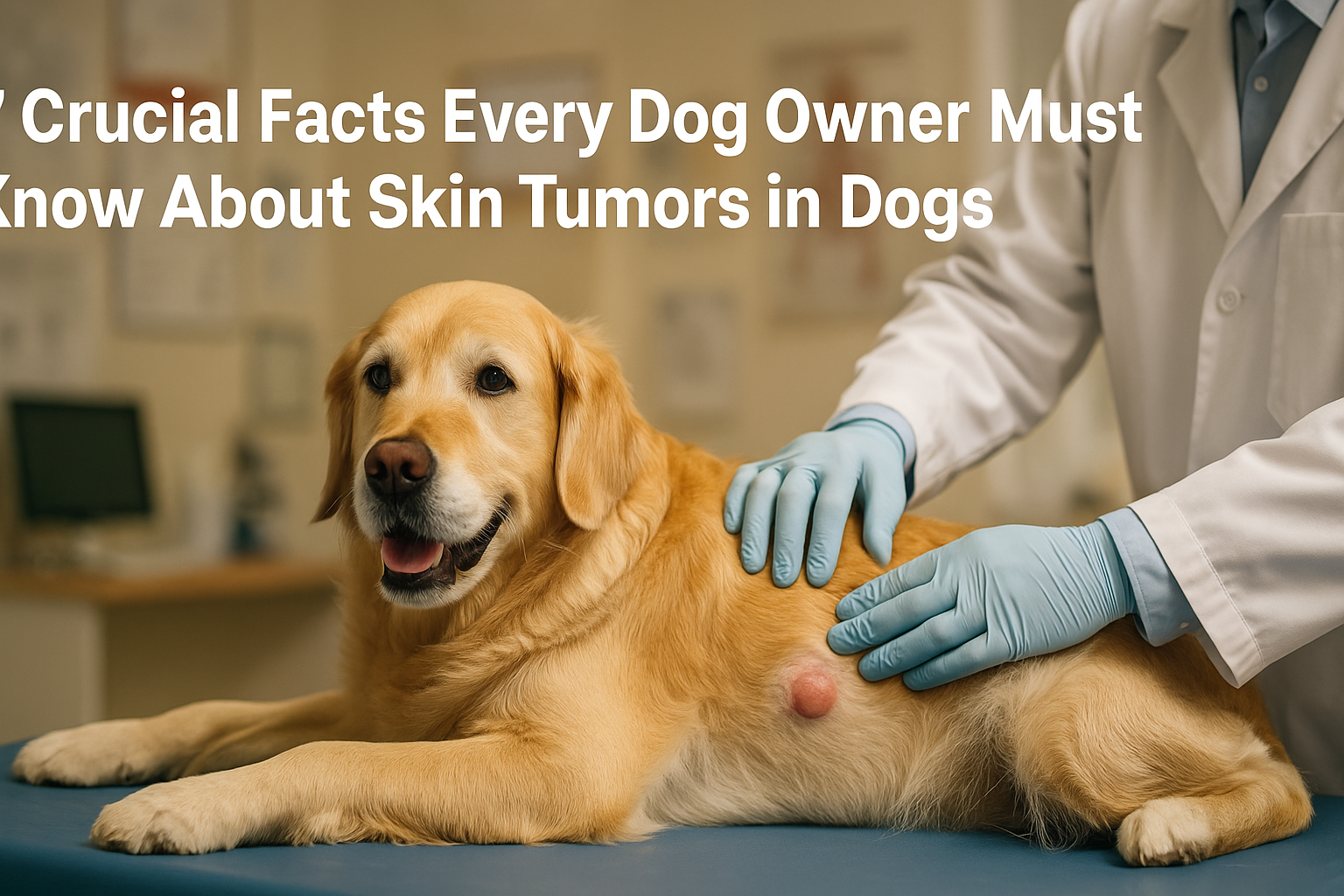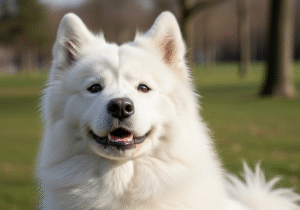Table of Contents
If you’ve ever run your hand across your dog’s back and felt an unexpected lump, you’re not alone. As a veterinarian, I’ve seen dozens of pet parents walk in with worry etched on their faces after finding a bump under their dog’s skin. The good news? Many of these turn out to be harmless. But some don’t, and knowing the difference can be lifesaving. This article covers what every dog owner needs to know about skin tumors in dogs, including the most common types, warning signs, and when to seek veterinary help.
Medical Disclaimer: This content is for informational purposes only and does not replace professional veterinary advice. Always consult your veterinarian for diagnosis and treatment specific to your pet.
✅ Key Takeaways
- Skin tumors in dogs are the most frequently diagnosed tumor type, accounting for about 33% of all canine neoplasms (Barnea et al., 2022).
- The majority of these tumors are benign, such as lipomas and histiocytomas, though mast cell tumors are often malignant and require prompt care (Withrow & MacEwen, 2020).
- Most skin tumors in dogs are visible or palpable, making home checks during grooming highly effective.
- A biopsy or fine-needle aspiration (FNA) is essential to distinguish benign from malignant tumors (ACVS, 2023).
- Early detection and surgical removal of skin tumors in dogs leads to the best prognosis, especially for malignant types like mast cell tumors.
What Are Skin Tumors in Dogs?
You can also visit: https://doglifeexpert.com/gut-health-and-skin-conditions-in-dogs/
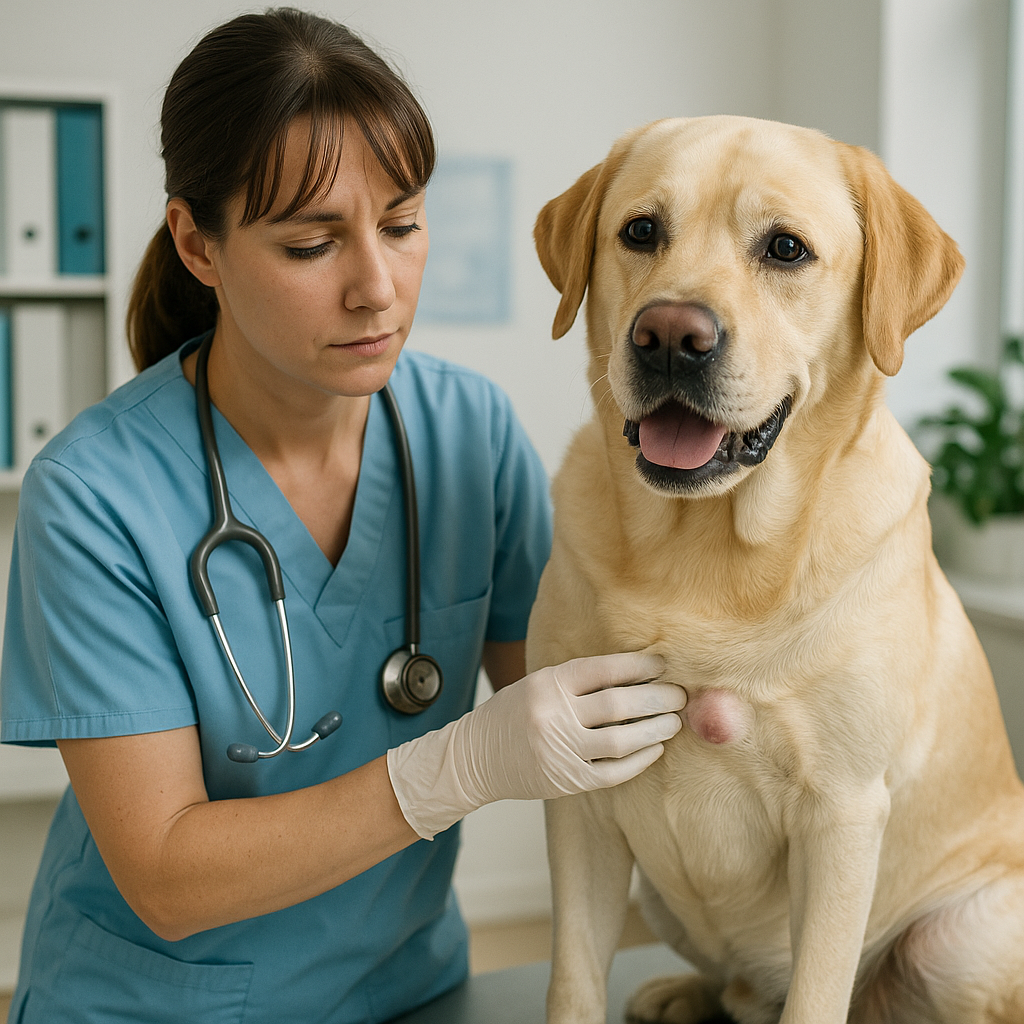
Skin tumors in dogs are abnormal growths or lumps that develop within the skin or just beneath it. These can be either benign (non-cancerous) or malignant (cancerous), and their appearance can vary widely from soft fatty nodules to firm, ulcerated masses.
Statistically, skin tumors in dogs are the most common neoplasm diagnosed in veterinary practice. A large-scale review by Barnea et al. (2022) found that cutaneous tumors account for approximately 33% of all tumors diagnosed in dogs. This makes the skin the most frequent site for tumor development in our canine companions.
Because the skin is the body’s largest organ and directly exposed to the environment, it is more susceptible to irritants, trauma, UV radiation, and infections, all potential contributors to tumor formation (Withrow & MacEwen’s Small Animal Clinical Oncology, 2020).
Benign vs Malignant Tumors
Roughly 70–80% of skin tumors in dogs are benign (CVMA, 2021). These tend to grow slowly, remain localized, and are often non-painful. Malignant tumors, on the other hand, may invade nearby tissues or spread to other organs (metastasize).
The tricky part? It’s nearly impossible to tell the difference by just looking or feeling. That’s why veterinary evaluation is essential.
What Are Skin Tumors in Dogs?
Skin tumors in dogs are one of the most common reasons pet owners visit the vet, often after discovering a new lump or bump. These abnormal growths form in or under the skin and can range from harmless fatty deposits to more serious cancerous masses.
Skin tumors in dogs account for roughly 33% of all diagnosed neoplasms, making them the most frequently identified tumors in canines. This high prevalence is due to the skin being the body’s largest organ and directly exposed to environmental irritants, UV radiation, and trauma. A 2022 epidemiological review published in Veterinary Pathology confirms that one in three tumors diagnosed in dogs are cutaneous in origin (Barnea et al., 2022).
Most skin tumors in dogs fall into two categories:
- Benign tumors: These include growths like lipomas or histiocytomas. They tend to grow slowly, are well-defined, and rarely spread.
- Malignant tumors: These can invade local tissue or metastasize. Common examples include mast cell tumors and squamous cell carcinoma.
According to the Canadian Veterinary Medical Association (CVMA), about 70–80% of skin tumors in dogs are benign. However, appearance alone can be deceiving. A soft lump might be harmless, or it might not be. Only a veterinarian can determine the true nature of a growth through diagnostic testing.
For a deeper dive into the biology and behaviour of skin tumors, Withrow & MacEwen’s Small Animal Clinical Oncology (6th ed.) remains a gold-standard resource in veterinary oncology.
Common Types of Skin Tumors in Dogs
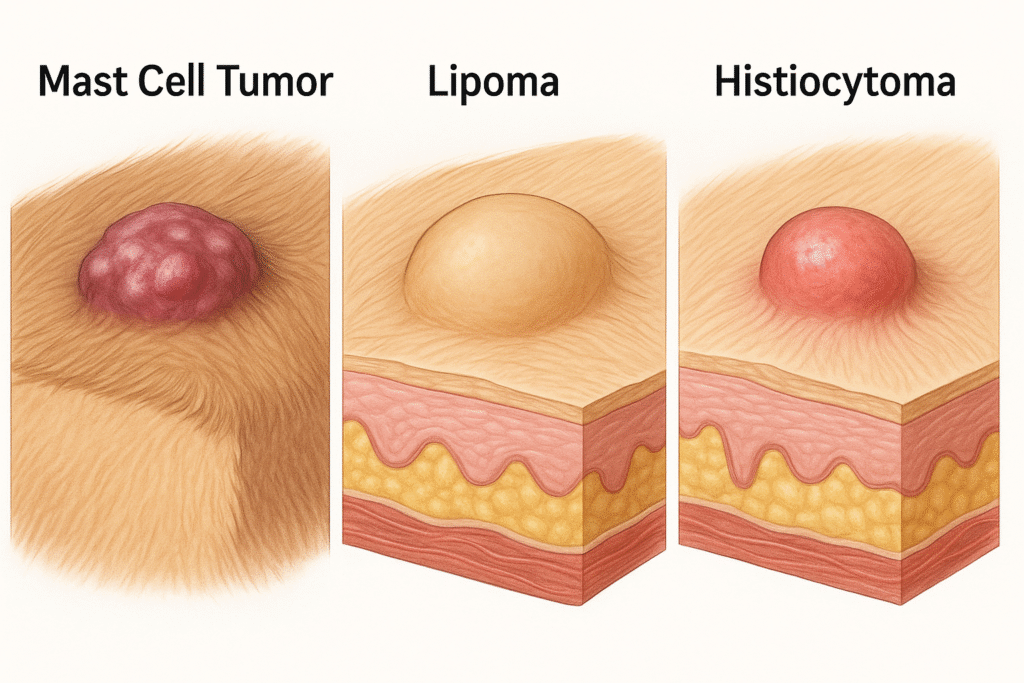
When it comes to skin tumors in dogs, some types appear more frequently than others. Recognizing them early can help guide treatment and ease anxiety.
1. Mast Cell Tumors (MCTs)
Mast cell tumors are the most common malignant skin tumors in dogs. They originate from immune cells and can release histamine and other inflammatory chemicals. MCTs can appear deceptively benign sometimes as small, pink nodules or larger ulcerated growths.
What makes them dangerous is their unpredictability. According to the Veterinary Cancer Society, some mast cell tumors behave indolently, while others metastasize rapidly, especially to the spleen, liver, or lymph nodes.
2. Lipomas
These are benign fatty tumors often found under the skin of older or overweight dogs. They feel soft, are usually non-painful, and can range in size. While they rarely become malignant, some can grow large enough to impair mobility or press against nearby organs.
Lipomas are among the most common benign skin tumors in dogs and are typically diagnosed through fine needle aspiration (FNA) rather than surgical removal unless they become problematic.
3. Histiocytomas
Histiocytomas are small, raised, often red lesions that appear suddenly, typically in young dogs under three years of age. Despite their angry appearance, they’re almost always benign and may resolve on their own.
As noted in Withrow & MacEwen’s Clinical Oncology, histiocytomas are considered self-limiting tumors caused by overactive immune cell responses.
Quick Reference Table
| Tumor Type | Malignant? | Common in | Key Traits |
|---|---|---|---|
| Mast Cell Tumor | Often | Middle-aged dogs | Variable appearance, may ulcerate |
| Lipoma | No | Older/obese dogs | Soft, movable, slow-growing |
| Histiocytoma | No | Young dogs | Red, dome-shaped, fast appearance |
By understanding these patterns, pet owners can better recognize concerning growths and seek timely veterinary care.
Signs to Watch For
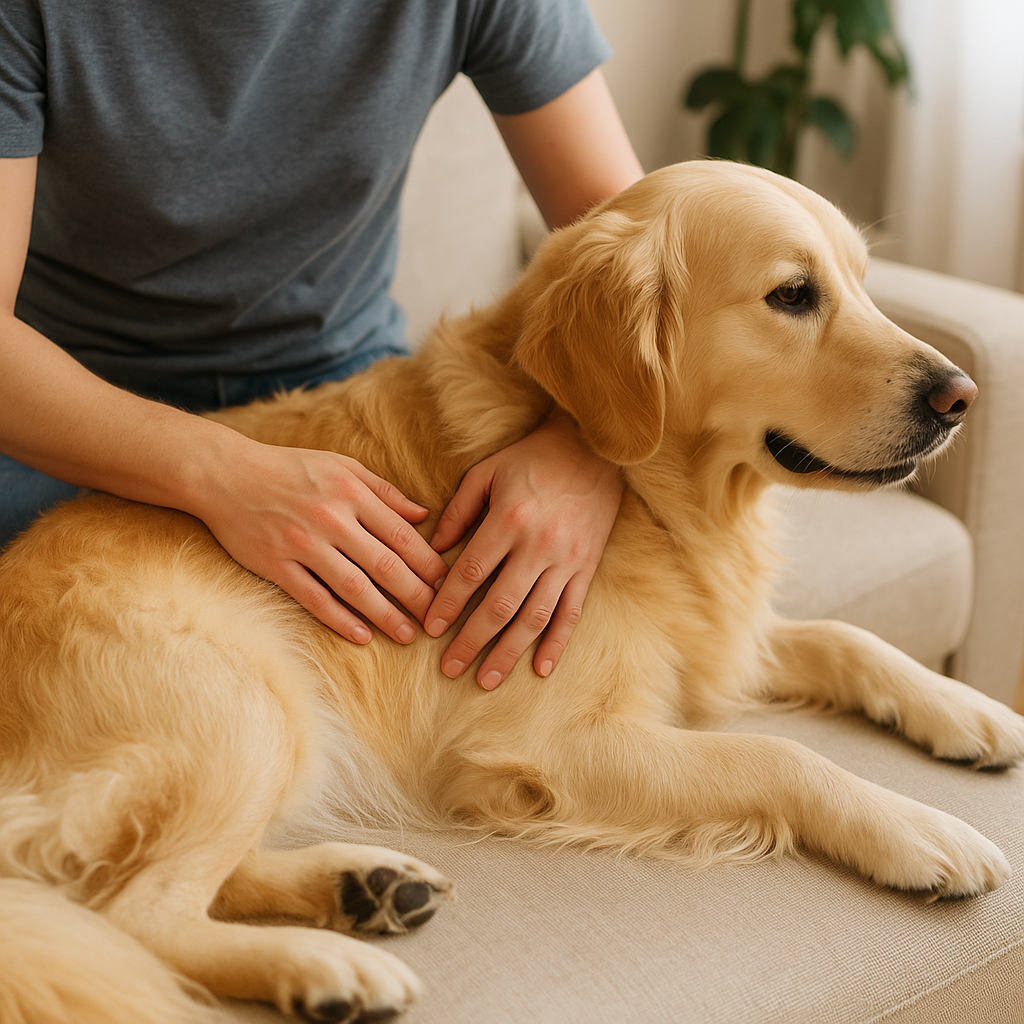
Most skin tumors in dogs are visible to the naked eye or easily felt during petting or grooming. This gives dog owners a crucial advantage: early detection.
What to Look For
Common warning signs of skin tumors in dogs include:
- New lumps or bumps, especially if rapidly growing
- Red, ulcerated, or bleeding areas
- Pigmented patches or irregular textures
- Tumors that feel firm, irregular, or inflamed
- Lesions that cause your dog to lick or scratch excessively
Some tumors, like lipomas, feel soft and move easily under the skin. Others, such as mast cell tumors, can become inflamed, itchy, or even trigger sudden swelling due to histamine release (Veterinary Cancer Society).
5-Minute Home Lump-Check Checklist
Try this monthly during grooming or snuggle time:
- Gently run your hands over your dog’s entire body, including armpits and groin.
- Feel for any new bumps, lumps, or thickened skin areas.
- Note changes in size, shape, texture, or colour.
- Check for any sore or scabby spots your dog may be licking.
- Record findings and compare them monthly or snap photos for reference.
According to the Canadian Veterinary Medical Association, early detection of skin tumors in dogs significantly improves the success rate of treatment especially when surgery is involved.
Benign vs. Malignant Tumors – What’s the Difference?
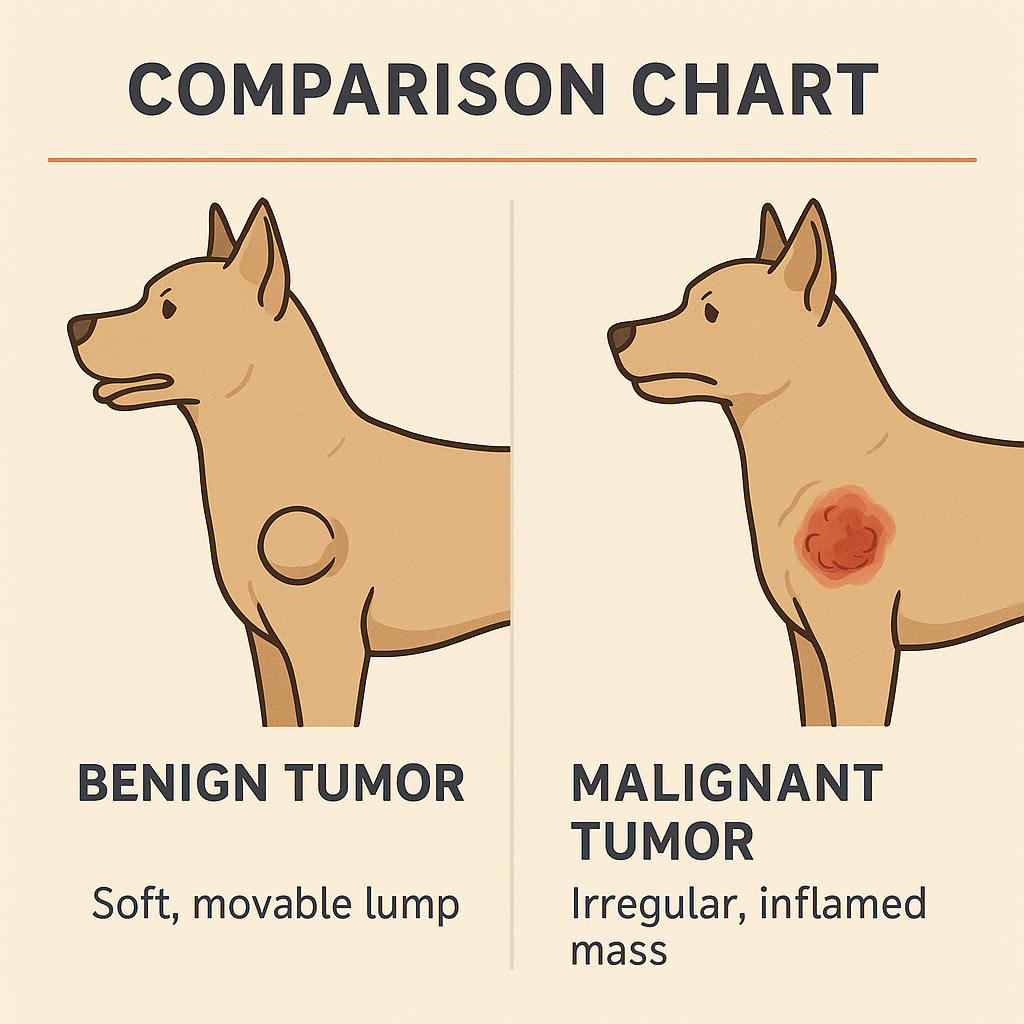
Distinguishing benign from malignant skin tumors in dogs isn’t something you can do reliably at home. Still, certain traits may suggest whether a lump is more likely to be harmless or worrisome.
General Clues
| Feature | Benign Tumors | Malignant Tumors |
|---|---|---|
| Growth Speed | Slow and gradual | Rapid or sudden onset |
| Mobility | Usually movable under the skin | Often fixed to deeper tissues |
| Pain/Discomfort | Typically painless | May cause irritation or pain |
| Surface Appearance | Smooth or uniform | Ulcerated, inflamed, or bleeding |
| Size Stability | Remains stable for months | Grows over time |
However, there are always exceptions. A small, smooth lump might be a malignant mast cell tumor, while a large fatty mass might be benign.
According to the American College of Veterinary Surgeons (ACVS), the only definitive way to diagnose a skin tumor in dogs is by performing either a fine-needle aspirate (FNA) or a biopsy. These procedures allow your veterinarian to collect cells or tissue for cytological or histopathological examination.
If there’s one takeaway here, never guess. Even if your dog’s lump “looks benign,” always let a veterinarian confirm it.
Why Mast Cell Tumors Need Special Attention
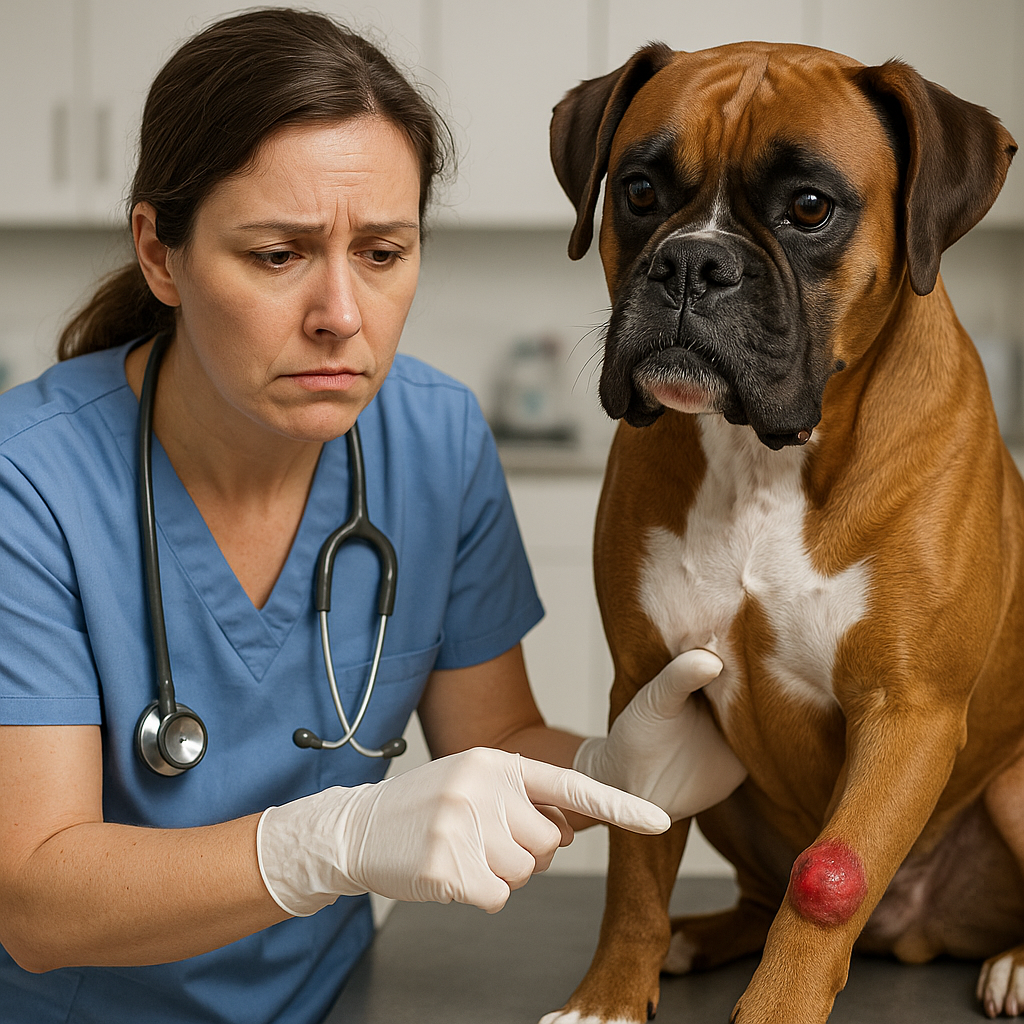
Among all skin tumors in dogs, mast cell tumors (MCTs) are perhaps the most unpredictable. They may appear harmless on the outside, but can behave aggressively beneath the surface.
MCTs originate from mast cells, immune cells that release substances like histamine and heparin. When triggered, these cells can cause localized swelling, redness, and itching. In more severe cases, systemic effects can include vomiting, lethargy, or even ulcers in the gastrointestinal tract.
The Veterinary Cancer Society notes that mast cell tumors are the most common malignant skin tumors in dogs. They can present as:
- Smooth or irregular bumps
- Swollen, itchy, or inflamed lesions
- Tumors that wax and wane in size
Due to their histamine-releasing behavior, even a mild-looking mast cell tumor can be harmful if left untreated.
Diagnosis and Treatment
Veterinarians often begin with a fine needle aspirate, which typically shows distinct mast cells under the microscope. From there, a biopsy helps determine the grade of the tumor, an essential step, as higher-grade tumors have a higher risk of recurrence or metastasis.
Surgical removal is the gold standard treatment. According to Withrow & MacEwen’s Small Animal Clinical Oncology, wide surgical margins and, in some cases, radiation or chemotherapy may be recommended for aggressive forms.
In short: if you suspect a mast cell tumor, don’t delay. Prompt diagnosis and treatment dramatically improve outcomes for dogs.
How Vets Diagnose Skin Tumors in Dogs
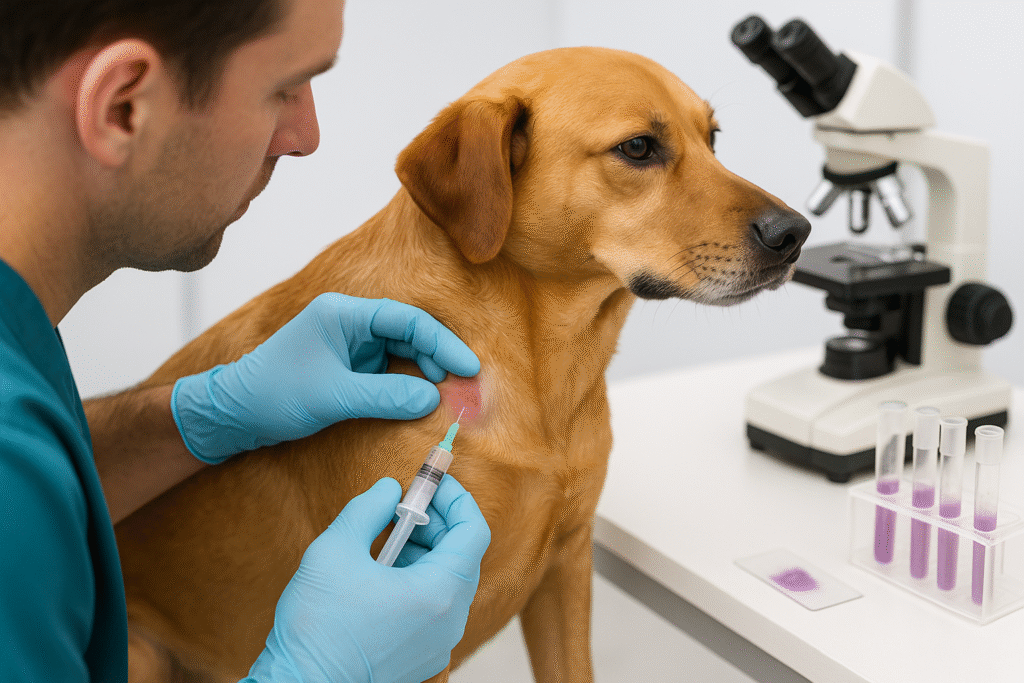
When you visit the vet with a suspicious lump, the diagnostic process aims to determine what kind of skin tumor in dogs you’re dealing with and whether it’s benign or malignant.
Step-by-Step Diagnostics
- Fine Needle Aspiration (FNA): A quick, minimally invasive test where a small needle extracts cells from the mass for microscopic examination. According to the American College of Veterinary Surgeons, FNA is often the first step and can offer immediate insights.
- Biopsy: If the FNA is inconclusive or the tumor appears aggressive, a tissue biopsy is performed. This may be a punch, incisional, or excisional sample submitted to a lab for histopathology.
- Histopathology: The gold standard for diagnosing skin tumors in dogs. It evaluates tumor grade, cell type, and margins to determine malignancy and guide treatment.
- Advanced Imaging (CT/X-ray): In cases where the tumor is deep, large, or possibly spreading, imaging helps assess the extent of involvement. This is especially important in locations like limbs, chest wall, or head and neck areas.
A well-staged diagnosis sets the foundation for appropriate treatment planning. As highlighted in Withrow & MacEwen’s Small Animal Clinical Oncology, early and accurate identification leads to better long-term outcomes.
Treatment Options for Skin Tumors in Dogs
Treatment for skin tumors in dogs depends on several factors: tumor type, size, location, and whether it’s benign or malignant. Fortunately, many tumors, especially when caught earl,y respond well to treatment.
Common Treatment Approaches
- Surgical Removal: This remains the gold standard for both benign and many malignant skin tumors in dogs. Complete excision with clean margins greatly reduces recurrence risk. According to the ACVS, surgical success is highest when performed early and with appropriate margins.
- Cryotherapy or Laser Ablation: Used for small, superficial tumors or in areas where surgery would be difficult.
- Radiation Therapy: Often used post-surgically for incompletely excised malignant tumors, especially mast cell tumors and soft tissue sarcomas.
- Chemotherapy: Reserved for systemic disease or non-resectable tumors. Drugs like vinblastine or prednisone may be used for high-grade mast cell tumors.
- Supportive and Adjunctive Care: Some pet owners explore natural remedies as complements not replacements, for traditional treatment. For example, medical-grade Manuka honey has shown antimicrobial effects on infected skin wounds (Barlow et al., 2020), but it does not shrink or treat tumors themselves.
Each case is unique, which is why a tailored plan from a veterinarian or veterinary oncologist is essential.
How to Monitor or Prevent Skin Tumors in Dogs
While not all skin tumors in dogs are preventable, early detection and consistent home monitoring can make all the difference. Pet owners are often the first line of defense.
Simple Prevention & Monitoring Tips
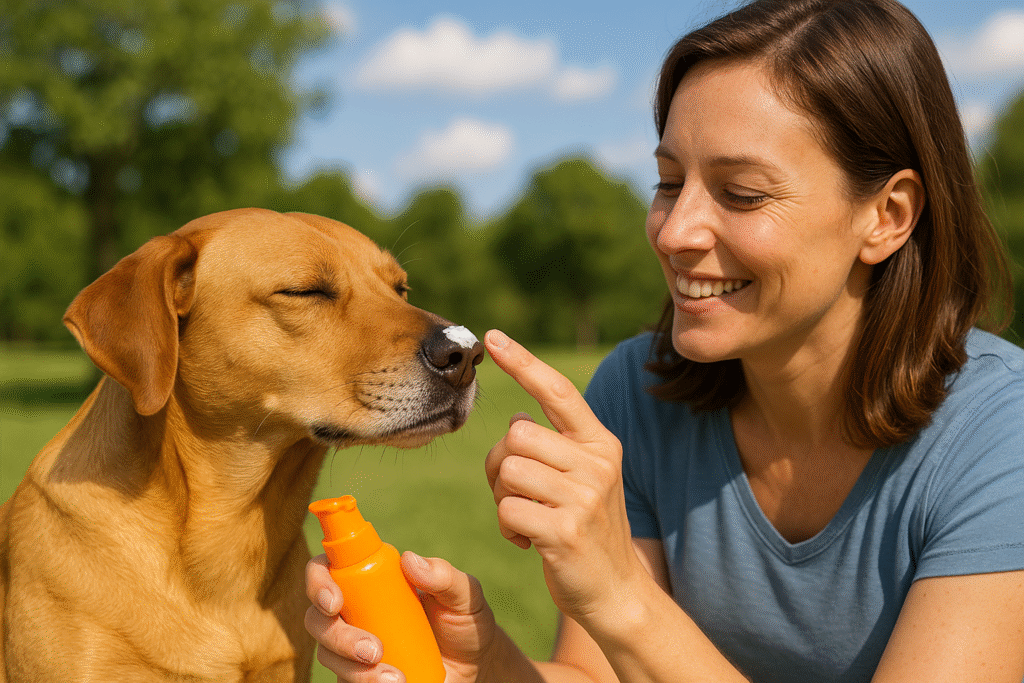
✅ Monthly “Lump Checks”
During grooming, gently run your hands over your dog’s entire body. Check under the arms, around the neck, belly, and legs areas where lumps can go unnoticed.
✅ Track Changes
Take photos of any lumps to monitor size, shape, and colour. Log the date you first noticed it.
✅ Maintain a Healthy Weight
Overweight dogs are more prone to benign fatty tumors like lipomas. A balanced diet and regular exercise help reduce risk (CVMA).
✅ Avoid Irritants
Use gentle, fragrance-free shampoos. Repeated skin irritation may contribute to tumor development in sensitive dogs.
✅ Protect Against UV Damage
Sun-induced tumors like squamous cell carcinoma are more common in short-haired or light-skinned breeds. Limit sun exposure and consider dog-safe sunscreen for at-risk areas.
As highlighted in Withrow & MacEwen’s Clinical Oncology, most skin tumors in dogs are treatable when caught early. Even malignant tumors can often be cured or controlled with prompt care.
Most importantly if something feels off, don’t wait. Early evaluation by your vet could save your dog’s life.
FAQs About Skin Tumors in Dogs
What causes skin tumors in dogs?
There’s no single cause. Skin tumors in dogs may result from a combination of genetics, environmental exposure (like UV radiation or toxins), chronic inflammation, or immune system dysfunction. Some breeds, like Boxers and Labrador Retrievers, are genetically predisposed to certain tumor types (ACVS).
Are skin tumors in dogs contagious?
No. Skin tumors in dogs are not contagious to other pets or humans. They result from abnormal cell growth, not infections or parasites.
Can skin tumors go away on their own?
Some benign tumors, like histiocytomas, may resolve spontaneously especially in young dogs. However, most skin tumors in dogs will remain or grow over time and should always be evaluated by a veterinarian.
How long can a dog live with a skin tumor?
It depends on the tumor type and whether it’s benign or malignant. Dogs with benign tumors like lipomas may live their full lifespan. Those with malignant skin tumors in dogs, such as high-grade mast cell tumors, can have shortened life expectancy if not treated promptly (Veterinary Cancer Society).
When should I worry about a lump on my dog?
You should be concerned if a lump grows quickly, becomes ulcerated, bleeds, or causes your dog pain. Any new or changing lump should be assessed by a veterinarian as soon as possible.
Final Words
As a veterinarian, I’ve seen the full spectrum of skin tumors in dogs from tiny, harmless bumps to rapidly growing cancers. What I’ve learned is this: trust your instincts. If something on your dog doesn’t look or feel right, don’t ignore it.
While the majority of skin tumors in dogs are benign, the small percentage that aren’t can be serious if left untreated. Early detection, timely veterinary assessment, and appropriate treatment offer the best outcomes. In many cases, surgical removal results in a complete cure.
Your dog can’t tell you something feels off, but your hands can. Keep checking, stay proactive, and always reach out to your vet with concerns. You’re your dog’s best advocate.

